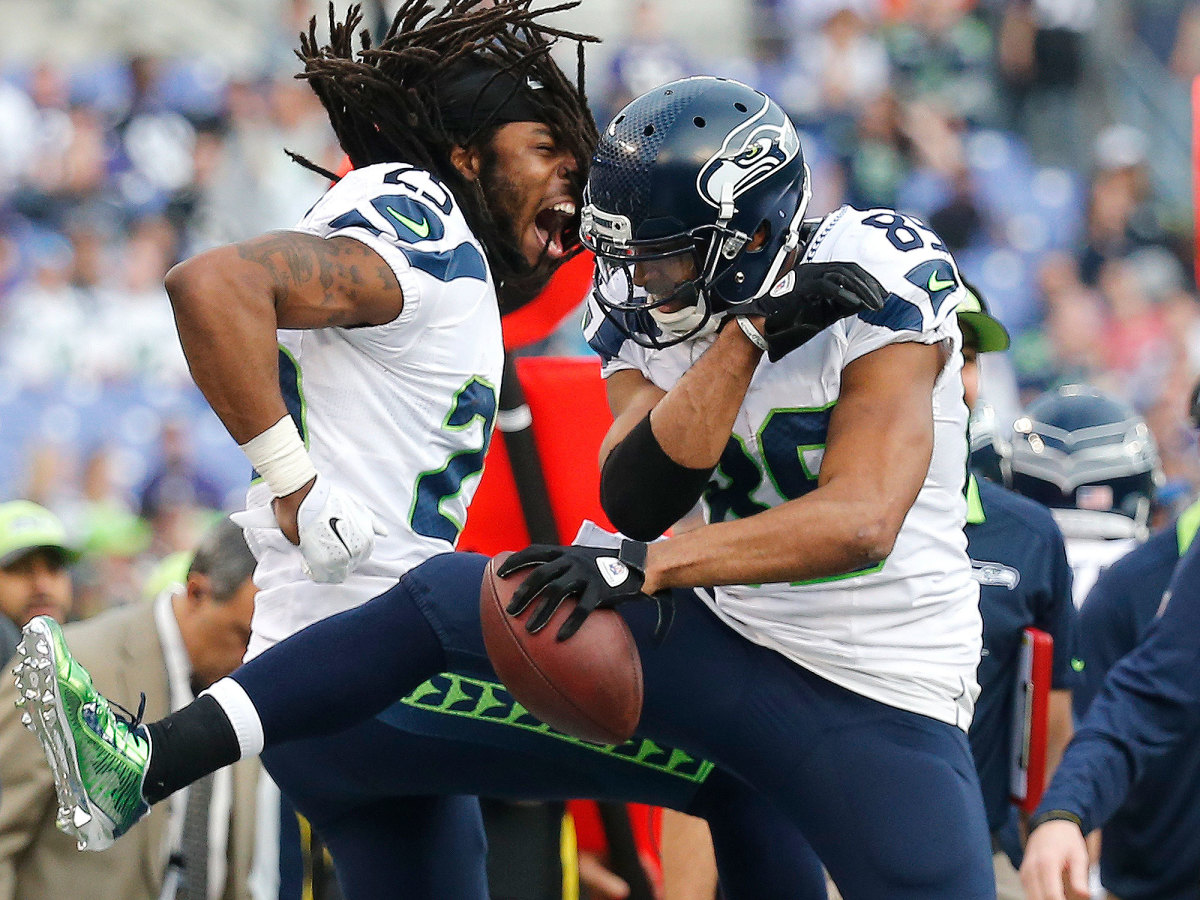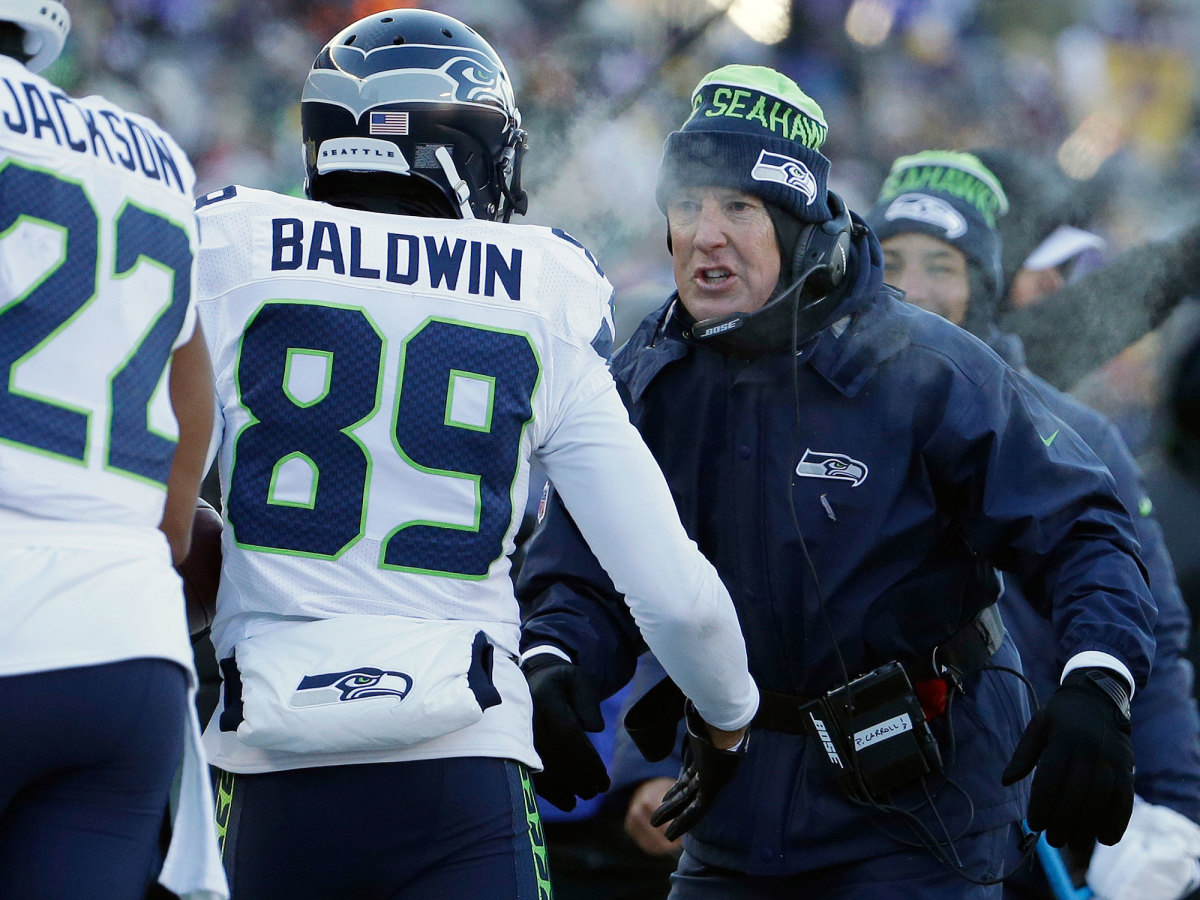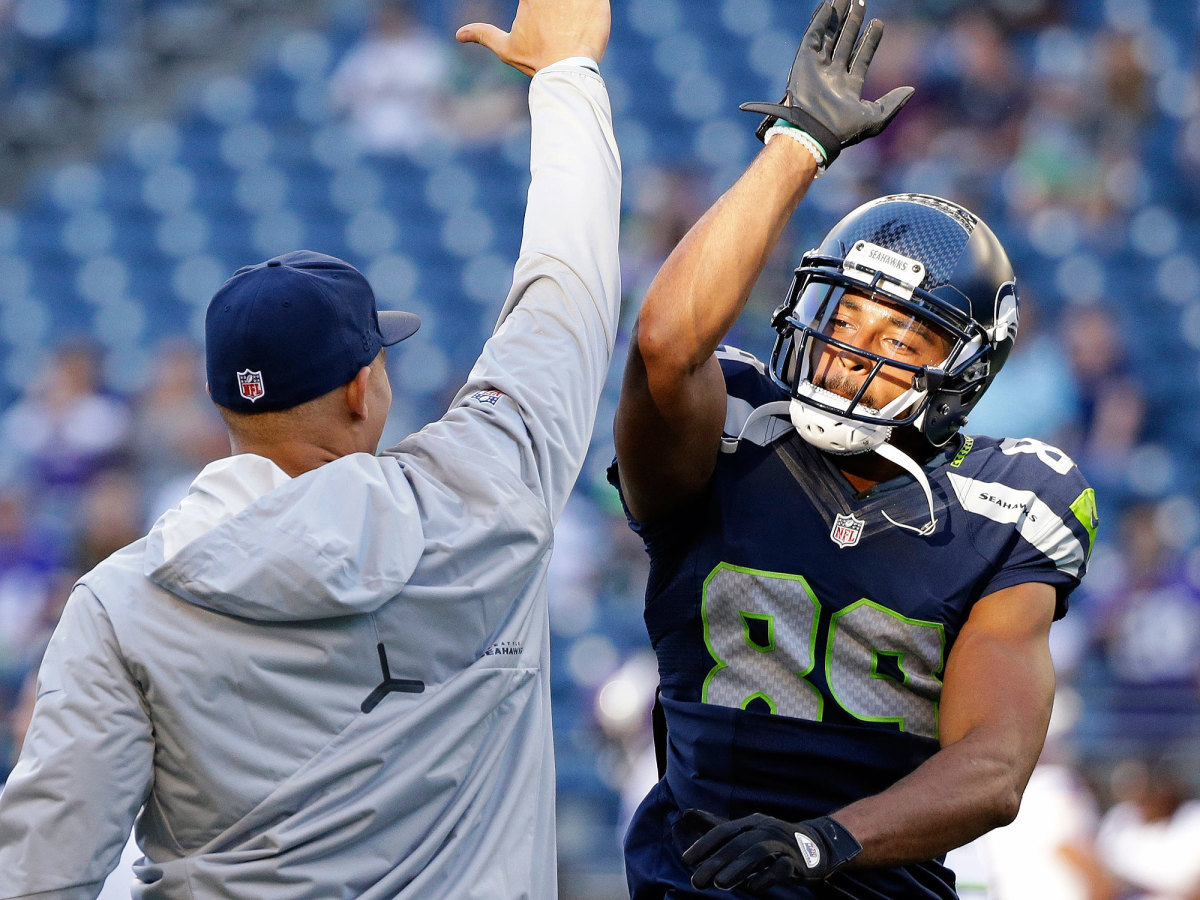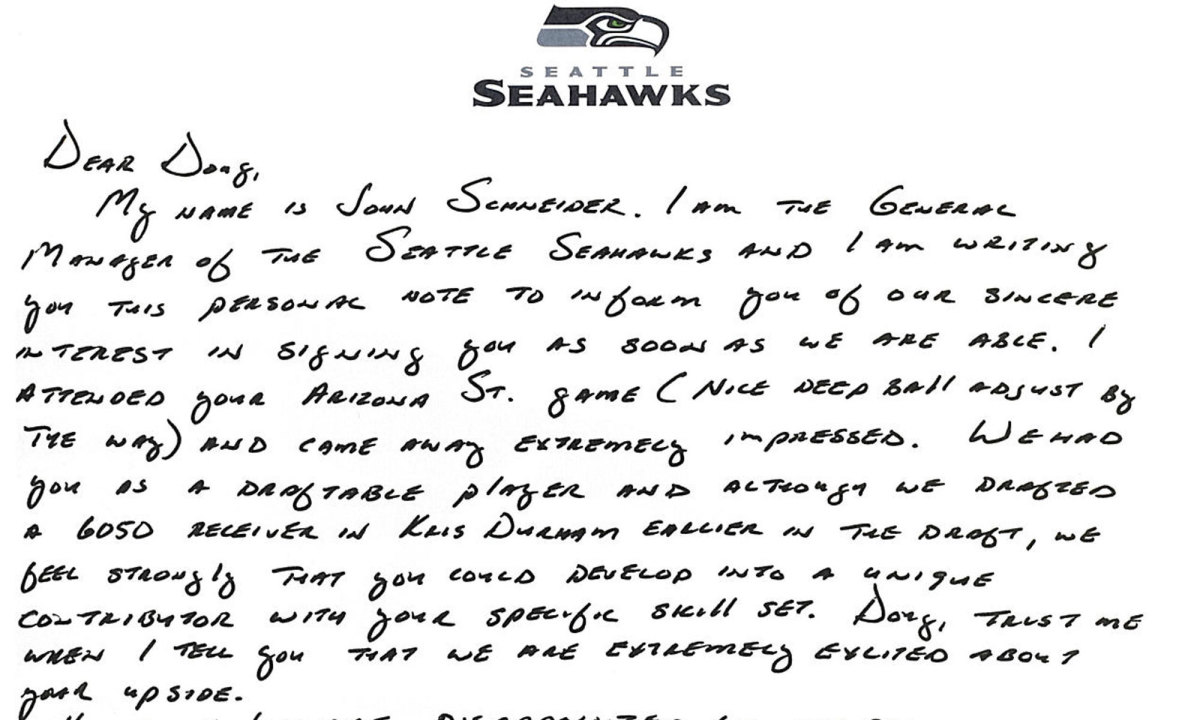Unpacking 'Angry Doug Baldwin', the NFL's most dangerous slot receiver

This story appears in the Aug. 22, 2016 issue of Sports Illustrated. Subscribe to the magazine here.
Inside the Theory of Knowledge classroom at Sumner High earlier this summer, the guest lecturer poses a moral quandary: Four people are stranded on a life raft in the ocean. One is near death after drinking too much seawater. With no help forthcoming, the speaker wonders, how does everyone feel about cannibalism?
Faces grimace and contort. Gross! The students know this presenter as Mr. Worthy, a classroom regular, equal parts deep thinker, agitator and contrarian. He works in Seattle, about 35 miles north of Sumner, and his visits constitute training for his second career, as a math teacher and coach.
The class ponders the obvious: Isn't it wrong to kill?
And Mr. Worthy—because this is his nature—takes the opposite position. He argues that one death is better than four, that inaction is worse than even eating another person.
The teenagers don't quite know what to make of Mr. Worthy. He's a 27-year-old millionaire who spends his free time at a local high school, expounding on the power of language, the importance of leadership and, for example, the ways in which snowmobiles have changed the dynamics of caribou farming in Alaska.
The scene is made all the more strange because Mr. Worthy is the classroom alter ego of Seahawks receiver Doug Baldwin. Which, really, would make that Baldwin's second alter ego, after his football persona, Angry Doug Baldwin. Last season, Angry Doug Baldwin—the moniker better known to fans and teammates—caught 78 passes for 1,069 yards, and his NFL-high 14 TD catches broke Seattle's franchise record. In the off-season, the former undrafted free agent proposed to his girlfriend, Tara Sabourin (she said yes), and signed a four-year, $46 million contract extension (with $24.25 million guaranteed).
• MMQB mailbag: Training camp conclusions | Andy Benoit scouts the Seahawks
At his primary job, teammates aren't always sure what to make of Baldwin either. There are so many Doug Baldwins.
There's Questionable Diet Doug Baldwin, who gorges on chicken teriyaki sandwiches at Subway, slices from Pizza Hut and wings at Applebee's. And Cheap Doug Baldwin, who wears the same white Air Jordans he received for playing in the 2009 Sun Bowl while at Stanford, maintaining them obsessively over the years with Clorox wipes. And Cerebral Doug Baldwin, who monitors the development of his prefrontal cortex, studies his social media metrics and starts each morning with mental-focus training, concentrating on only his breathing.
Baldwin wrestles with a stressful combination of personality traits that, altogether, make him an All-Pro worrier. (Worrying Doug Baldwin can be difficult to be around.) He can be stubborn and ornery, so much so that his own mother, Cindy, describes her son as "a little intense" and says "there's been a process there." He is anxious. Sometimes lonely. And, above all, sensitive. He's aware of every time anyone has doubted him and he wants to be recognized as one of the best receivers in pro football, an integral cog on a dominant team. He's still not over the 'pedestrian' label used two years ago to describe Seattle's wideouts. There's fight inside Baldwin—but mostly it's the fight inside his head.
Why all of this matters: Over the final two months of last season, with three-time Pro Bowl tight end Jimmy Graham on the disabled list, running back Marshawn Lynch ailing and his team in overall disarray, all of these versions of Baldwin somehow coalesced into ... Ideal Doug Baldwin, an elite receiver from late November until the Panthers ended his season in the divisional round. "Our team really elevated, and what you saw from him is basically our blueprint," Seahawks coach Pete Carroll says. "Doug is the epitome of what we look for. A heartbeat guy. Grit. Tough. Something to prove."
That's the Baldwin everybody wanted, the Baldwin that remains essential to another Seattle playoff run.

In Week 10 last season the Seahawks stumbled against the Cardinals, a rare home loss in the Carroll era that dropped Seattle to 4–5. Late in the game Lynch gathered his teammates. "We don't look familiar!" he shouted. "This is not our standard!"
Baldwin felt the same way, and that led him to ask the question that defined his 2015 season. He considered how his words might affect his teammates. He asked himself: Is this an argument worth having?
"F--- it," Baldwin decided, and so he took a stand in a team meeting, calling out Carroll in front of everyone. "We have to do something different,"Baldwin said.
These Seahawks had won and lost a Super Bowl in the previous two seasons, overcoming early losses in each campaign. Baldwin felt complacency settling in. His teammates had become too comfortable. They expected another late-season surge.
As Baldwin remembers, his conversation with Carroll continued onto the practice field. "You're the head coach of the Seattle Seahawks," Baldwin said. "Nobody is going to tell you what you don't want to hear. But I'm not that, Pete. I'm going to tell you the truth; I can't change, I can't compromise that. We can't just say, It's going to be O.K. It's not. We need change, and we need it now."
Carroll walked away, and the two didn't talk for a day. But the coach pulled Baldwin aside later that week and told him he was right. (Reminded of the story in July, Carroll pauses. "I don't remember that," he says, followed by, "but that sounds about right" and "I'm sure it happened.")
SI's Super Bowl LI pick: Why the Cardinals will beat the Steelers
Nobody can say with certainty how that confrontation affected the remainder of Seattle's season. But the Seahawks did go on to win six of their final seven regular-season games, and in those outings Baldwin caught 11 TDs—an impressive total over an entire season, let alone half of one.
In hindsight, the change Baldwin had called for happened rather organically. Graham tore the patellar tendon in his right knee on Nov. 29, two weeks after the argument (and shortly after coordinator Darrell Bevell challenged the offense to execute with better precision). The Seahawks responded by playing better. They focused on shorter passes, emphasizing a more fluid, faster rhythm, and that benefitted Baldwin, a slot receiver who can separate from defenders with ease.
Against Pittsburgh, Baldwin found quarterback Russell Wilson on the sideline. "We have to f------ do this," Baldwin said. "No more excuses." They connected for three touchdowns, including one that put Seattle up for good. The momentum carried over. "It was a different feeling," he says.
He led all NFL receivers with 1,007 yards coming from the slot, according to Pro Football Focus. He was the only pass catcher—not Antonio Brown or Julio Jones—who ranked in the top 10 in yards after the catch and in plus-minus, a Football Outsiders stat that measures efficiency. And in the wild-card game against the Vikings, in the third-coldest matchup in NFL history, he led both teams in yards and receptions, including a leaping, twisting, one-handed grab—his best Odell Beckham Jr. impersonation, the kind of catch a No. 1 receiver makes. He also scored the only touchdown that afternoon in Seattle's 10–9 victory and afterward wrapped general manager John Schneider in a locker room bear hug.
"He's one of the more underrated people and players in the league," says an admittedly biased Schneider. "I've never understood why he doesn't get more credit."
Baldwin views the confrontation with Carroll as central to his 2015 campaign. It signified personal growth, the payoff from years of gaffes and introspection. It showed a willingness to pick and choose his battles—and more importantly, the ability to pick the right one. "That was the deciding factor, what changed everything for me," Baldwin says.
He then says something the public won't hear from many football players: "Self-awareness was my engine."

The Pensacola Bay Bridge, a stretch of Route 98 in northwest Florida, connects the panhandle city with its suburb, Gulf Breeze. The Three-Mile Bridge, as it is known to locals, is rife with symbolism for Baldwin, representative of a childhood suspended between two worlds.
Baldwin grew up in Gulf Breeze, a wealthy enclave with sugar-white sand beaches and few families like his own, middle-class and African-American. He played organized sports, though, mostly in Pensacola, a more diverse, less affluent city across the bay.
In Gulf Breeze, Baldwin felt like an outsider. His family wasn't poor—his mother managed a private-practice medical clinic; his father was a policeman—but he wasn't as wealthy as most of his classmates. Surely none of them went Dumpster diving, collecting aluminum cans for extra cash, as Baldwin did with his grandfather, Junius Boling. They didn't wrestle with casual, everyday displays of racism, like the noose Baldwin spied hanging from a Gulf Breeze teammate's rearview mirror his sophomore year. The teammate found it funny, a part of history, he explained, like the Confederate flag. "I couldn't relate to any of them," Baldwin says.
Pensacola wasn't any better. Friends there called Baldwin rich, which meant stuffy and moneyed, the implication hanging in the Florida air as thick as the humidity: too white. "I really didn't have anybody I was close to," Baldwin says. "You were either with me or you weren't, and if you weren't, it was like, F--- you. I carry that to this day. I'm working through it, but it's in me."
His insecurity, compounded by the limited interest from college football powerhouses, bubbled into anger. On the field, Baldwin patterned himself after Steve Smith, another receiver born with a football Napoleon complex—Smith is 5' 9"; Baldwin is 5' 10"—and who played as if affronted. He wore Smith's number, 89, and still watches a YouTube video of Smith's highlights before every game. In Baldwin's favorite part Smith says, "They told me I was too small. I wasn't strong enough. I wasn't fast enough. But I run this." The first time Baldwin saw that clip, he thought, That's me.
That was him at Stanford: short, doubted, aggrieved, combustible, even banished to the scout team during his junior season. Another bridge, this one apparently burned. "Coach [Jim Harbaugh] essentially wrote him off as being a selfish, uncoachable guy who put himself above his teammates," says Shannon Turley, Stanford's sports performance coordinator. "Some of his focus and energy was misdirected when he was young."
For all his with-me-or-against-me talk, Baldwin cared deeply about how others viewed him, about making the NFL. But he couldn't always stay out of his own way. He cared too much. That's still evident at an LA Fitness in Bellevue this spring as Baldwin plays pickup basketball with Super Bowl-worthy intensity. The player he guards wears a SAVE WATER, DRINK BEER T-shirt, and yet Baldwin treats him like Steph Curry. "Come on, Doug!" he yells at himself after a missed basket. He puffs out his chest following a dunk.
"What Doug needed was to control all that emotion," Turley says. "Looking back, I almost can't believe he did it.
"He's the most mentally disciplined guy I've ever coached."
2016 fantasy football draft kit: Position rankings, cheat sheets and more
Turley approached Baldwin like a self-help guru. Control what you can control, he told him. You can't control your playing time. You can't control coach Harbaugh. Slowly, the message started to sink in, and when wideout Chris Owusu missed time with an injury in the fall of 2010, Baldwin slid from the Cardinal scout team into the starting lineup. In control of his preparation, he was ready for a final shot in his last college season.
Baldwin scored twice in Stanford's opener against Sacramento State and finished the year with 857 receiving yards and nine touchdowns, the closest approximation to his NFL breakout last season. "He got hot, man," says his quarterback that season, Andrew Luck. "It seemed like he was scoring every week."
That marked the year Baldwin took everything that made him angry—his hometown, his coach; his life to that point, basically—and channeled those emotions onto the field. He also honed his skill set: the Ferrari acceleration, the shiftiness to separate from defenders, how best to utilize the long arms that made up for what he lacked in height. The Cardinal finished 12–1 and trounced Virginia Tech in the Orange Bowl. "You know how people say someone plays with a chip on his shoulder?" Luck asks. "He had a bag of chips on each shoulder."
Those chips, while helpful on the field, appeared to hurt Baldwin in the 2011 draft. He watched the later rounds on TV at a Mexican restaurant near campus, each slight another log for the blaze that raged within. Unbeknownst to him, though, the Seahawks had graded Baldwin as a fifth-round talent.
That summer he received a handwritten note from Schneider that outlined the Seahawks' philosophy, their emphasis on competition and their need for a "move the chains" wideout. "We are extremely excited about your upside," Schneider wrote, despite the words of caution his staff had received from Stanford coaches.
"It wasn't like we got these glowing reports about what an awesome kid he was," Schneider says.
The letter Seahawks GM John Schneider wrote Doug Baldwin after the 2011 draft
Baldwin couldn't concern himself with bad report cards. Anger equated to survival. In Seattle his teammates noted how rarely he joked or smiled, and he again felt like a loner, a part of the team and yet apart from it. He found another mentor in Sidney Rice, the veteran receiver who after their first practice together predicted that Baldwin would make the 53-man roster. Rice had never seen a receiver separate from defenders the way Baldwin did. That resulted from natural ability, sure, but also from extra practice and hours of film study, the products of an (often unhealthy) obsession to prove himself.
Philosophically, the Seahawks want their players to be themselves, to play free and without worry or anxiety. But being Doug Baldwin was part of the problem. He always fretted, especially off the field, fixating over plays in practice or conversations in the locker room. No matter what he accomplished—making the team that September, becoming a part-time starter in year two, inking a second contract after year four—nothing satisfied him. When the Seahawks trampled the Broncos in Super Bowl XLVIII, Baldwin hadn't even left the field before he moved on. He recalls thinking, Oh, that's all that was?
He isn't selling this narrative like a shoe commercial, where never-satisfied is supposed to equate to some wholesome drive to win. He doesn't disagree with those who label him neurotic. He wishes he could let things go, turn his brain off, not care so freaking much. It truly bothers him how little he has enjoyed things, how doubt and apprehension have consumed him. His drive—the desire, for one, to catch 500 more passes daily than he's asked to—can overtake his life, and that disconnect creates even more anxiety ... which only deepens his obsession with what's next. It can be, he admits, a brutal way to live.
He's also aware of how his internal strife projects to his teammates, at times making him seem selfish and obsessed, more of an island than a leader. That has manifested in confrontations, like in Baldwin's rookie year in Seattle when he lived with his college teammate Richard Sherman. One day Sherman, sick of arguments over dishes and whatnot, pulled off the freeway so they could fight. (They didn't. Sherman also does not recall this particular incident, such was the frequency of the dust-ups.) Baldwin moved out with four months remaining on their lease.
"Doug is like the little brother I never wanted," Sherman says. "I want him to be happy. I'm like: Dude, relax."

Inside the Seahawks' waterfront headquarters in Renton, Wash., on a recent afternoon, Baldwin works out on his own. His routine centers on massages and abdominal torture and, well, trading insults with trainers. He seems most comfortable around the support staff. Sample barb from a trainer, directed to a visiting reporter but meant for Baldwin: "Do you need an extra notepad for when Doug starts talking about himself?"
His routine lasts for several hours, a mishmash of kettle bells and rubber balls and bicycle kicks. Baldwin honed his recovery methods in 2012, his second season, after suffering a high right-ankle sprain, a torn left hamstring, a bum left shoulder, right-quadriceps tendinitis, a busted rib cage and two lost front teeth.
He's smarter now, and older, and a key voice on the group text message thread kept by Seahawks wideouts past and present. A day earlier someone complained about the spring workload, and Ricardo Lockette, the retired Seahawks receiver who was nearly paralyzed after a collision last season, responded that they should all "approach every practice like it's their last." Afterward, Baldwin made sure those words resonated, further evidence of his changing status in the locker room.
The longer Baldwin has played in the NFL, the more he has studied leadership. It became his obsession and birthed his business, a leadership consulting firm. He wondered why the players that he considered true leaders—Lynch, who hung up his cleats in February; center Max Unger, now with the Saints; and defensive tackle Brandon Mebane, now with the Chargers—rarely received public credit, while others bathed in accolades that contained truths, but only to a point. He describes the famously moody Lynch as "the greatest teammate I've ever had," noting that Lynch once gifted him the Gucci backpack right off his burly shoulders. But Lynch's impact, Baldwin says, extended beyond superficial gestures. It stemmed from how the running back carried himself, how he actively shunned credit and how much he cared about the team.
Throughout the past two seasons, with Lynch as an unexpected role model, Baldwin redirected his focus away from selfish pursuits, toward more team-oriented ones. He softened—as much as someone like him can soften—his approach with younger players. He considered the purpose in yelling—again, relative to his personality—before he yelled. He didn't quiet or mellow, but he learned a little finesse. "He's grown so much, but he's still Doug Baldwin," Sherman says, laughing.
As Baldwin evolved, he continued to seek out mentors, like Steve Largent, the Hall of Fame Seahawks wideout who related catching passes to shooting clay pigeons—concentrate on the tip, rather than the middle. He says Baldwin was "the first player I can ever remember contacting me. He wanted to be better—that showed foresight."
There have been missteps: the locker room door Baldwin dented following a loss in Dallas; the celebration after he scored in Super Bowl XLIX where he pretended to—there's no graceful way to say this—poop on a football; the forceful tweet in April, aimed at Carroll, insisting that no player wear Lynch's number 24. But Angry Doug Baldwin, Misguided Doug Baldwin, all those head-shaking versions of Doug Baldwin surfaced far less often, drawing respect from the shut-up-and-play-football crowd that had grown tired of Baldwin's rants.
This new Baldwin (call him Only Occasionally Angry Doug Baldwin) played nice in the locker room and had greater impact on the field. "This is the most comfortable I've ever felt in my life," Baldwin says. "I'm still conscious of whether people really accept me, but that insecurity makes me stronger. I care about what's best for everyone around me."
He's asked, then, if he feels totally accepted—if he ever will.
"Never," Baldwin says. "But I'm trying."

Baldwin settles into a booth at an otherwise empty Subway, clad in a pinstripe suit following a charity appearance for the Leukemia and Lymphoma Society. He recently celebrated his contract in similar low-key fashion: cheap pizza and a bottle of Martinelli's sparkling apple cider with his fiancée. The deal made Baldwin one of the highest-paid receivers in football, but while validating, it didn't change anything, including his dining habits.
Instead, the pact crystallized for Baldwin the answer to the dominant question of his off-season: Why does he play football? And even though Baldwin decided before negotiations that he wouldn't accept an offer of less than $11 million a season (he got $11.5 million), he insists that it wasn't about the money. It was, he says, about what the money meant: that the strides he made in recent seasons had led to his best year and enough dough to buy 9.2 million $5 footlongs, should he continue to eat fresh.
That's easy to say now, of course. But Baldwin is in some ways channeling his sensei, Carroll, who turns 65 next month and yet continues to evolve his own approach. Two years ago, Baldwin reminded his coach that the NFL isn't USC—the college program Carroll powered from 2001 through '09—and rosters don't turn over every four years. He cited Win Forever, the volume on coaching philosophy that Carroll coauthored in 2010. "Now you've gotta write your second book," Baldwin said. "These guys keep hearing the same s--- over and over. They can recite it in their sleep."
Carroll recounted that conversation to the team this spring, after realizing that most of the Seahawks' core had arrived between 2010 and '13. Those players had been hearing him wax philosophical for at least three seasons, some as many as six. He understood the inherent danger there, of saying the same thing to the same people over and over. When Schneider worked under coach Marty Schottenheimer in Kansas City, Schottenheimer told his staff: All coaches and personnel types must move on after five or seven or nine years—whenever players stop hearing them the way they once did.
True to form—Carroll's being fluid and largely unconventional—the Seahawks' coach spent less time focusing on how he planned to operate and more time on why he operates the way he does. He invited speakers—a Navy SEAL, former players like Michael Robinson and several current Seahawks—to share their whys too. For Carroll, this meant detailing his personal history: why he loved football, why he became a coach, why he was twice fired from NFL gigs, why he took a year off and why he promised himself he would adapt but never waver from his core principles. "I felt it necessary to elevate the depth of our relationship," Carroll says. "I had never done that before."
His players, while familiar with the basics of his story, had never heard it in such detail. "It helped us," Baldwin says, "to reconnect with him, to relate with him. Pete allowed himself to be vulnerable with us."
They aren't so different, this tempestuous wideout known for blowing his cool and this laid-back coach who oozes California charm. Before the Seahawks scattered on vacations in June, Carroll assigned a little summer reading, Rules for a Knight by Ethan Hawke. In the book a knight, on the eve of battle, reveals advice to his children. Baldwin—on the cusp of marriage, wanting a family, focused now on more than himself—has already read it three times. He's training his thoughts on his legacy, his business, another playoff run and gathering material for Mr. Worthy's first lecture at Sumner in the fall.
He's still angry, stubborn, sensitive—still Doug Baldwin, more or less. How he plays football has always been obvious. As for why? That's different now.
